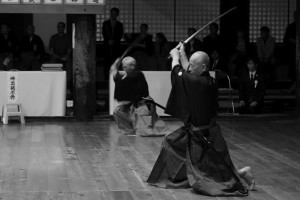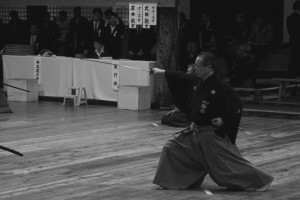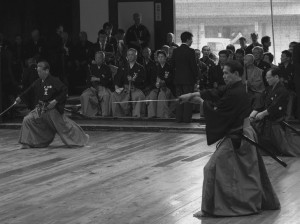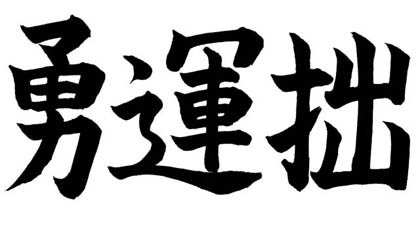Your first nukitsuke reflects your training years
 Iaido season started very well with as usual a great ABKF Summer seminar. While posting a small resume I discovered an unpublished article draft started in 2011 so I decided to finish it and am posting it now. The topic being: How are the high graded sensei judging a performance and what are they looking at ? Technical mistakes or simply put the non respect of the points written in the ZKR Iaido booklet is already a very bad start. I suppose everybody will agree so let’s postulate those points are respected. Then what are the other aspects judges may look at ? This post lists a non-exhaustive and unordered series of points highlighted by different 7th and 8th dan sensei during seminars and in various articles …
Iaido season started very well with as usual a great ABKF Summer seminar. While posting a small resume I discovered an unpublished article draft started in 2011 so I decided to finish it and am posting it now. The topic being: How are the high graded sensei judging a performance and what are they looking at ? Technical mistakes or simply put the non respect of the points written in the ZKR Iaido booklet is already a very bad start. I suppose everybody will agree so let’s postulate those points are respected. Then what are the other aspects judges may look at ? This post lists a non-exhaustive and unordered series of points highlighted by different 7th and 8th dan sensei during seminars and in various articles …
Are you showing depth of practice ?
This is the first point of the ZKR Iai booklet article 12. Fûkaku and Hin’i being key elements. Those characteristics can be judged by the stance and attitude (body/spirit) of the candidates. It is the first thing the Jury will see when entering the embu-jo followed by the general perception of your embu. Candidates should show their self confidence in their technique by the way they moves, occupy the space and how fluid and precise their actions are. Fûkaku and hin’i are not something that can be faked and of course it is not easy to achieve combination of natural “Elegance/Style” and effectiveness in technique. It can only be acquired through continuous and hard training. By doing so, your waza will become second nature, and an “air of grace” will naturally manifest itself in your movement. “HYAKUREN JITOKU” (百錬自得) – Natural acquisition through repetitive training.
Does your nukitsuke reflects your training years ?
 Targeted here are examination, taikai, demonstration but also the hypothetical sudden combat situation. During these events you will probably have to wait for a long time before action, most of the time having no opportunity to warm up. It is one of the thing you have to train for. Your first nukitsuke/kiritsuke is maybe one of those moments where you have no choice but to do it correctly and with all your heart, showing tenouchi and strong usage of sayabiki. With the stress and tension of such events one’s should be able to stay calm (heijoshin) and blindly trust their personal training years. If at that moment you try to do something that is not in your habit, cut stronger, wider, bigger it is probably a recipe for disaster and the jury will see and feel your are not acting naturally.
Targeted here are examination, taikai, demonstration but also the hypothetical sudden combat situation. During these events you will probably have to wait for a long time before action, most of the time having no opportunity to warm up. It is one of the thing you have to train for. Your first nukitsuke/kiritsuke is maybe one of those moments where you have no choice but to do it correctly and with all your heart, showing tenouchi and strong usage of sayabiki. With the stress and tension of such events one’s should be able to stay calm (heijoshin) and blindly trust their personal training years. If at that moment you try to do something that is not in your habit, cut stronger, wider, bigger it is probably a recipe for disaster and the jury will see and feel your are not acting naturally.
Is your Hasuji and Metsuke correct ?
Maybe one the most devastating mistake a high grade candidate could do is the incorrect usage of the hasuji and Metsuke. The simple fact that the hasuji, the angle of the blade is not correct or not matching the kata story (Riai) and a wrong Metsuke is an indication that the candidate is not understanding/mastering the very foundation of the kata and the principle of the sword.
Is your cut the natural continuation of your seme ?
 Your seme and the cut that follows are part of the same action and should be performed as a whole. Slowing down or stopping before the sayabanare is a common mistake. For this the understanding of the jo-ha-kyu and suki (opening) is essential.
Your seme and the cut that follows are part of the same action and should be performed as a whole. Slowing down or stopping before the sayabanare is a common mistake. For this the understanding of the jo-ha-kyu and suki (opening) is essential.
Is your breathing correct ?
Few of the articles or seminar notes were mentioning breathing technique. Our shishoo Oda sensei is very attentive to this and always emphasize that high grade candidates should be able to use a correct Kokyu. If we take the Japanese ZKR Iai book it is noted “Kakuwaza wo ikkokyu de oerukoto ga nozomashiiga, samonakuba tekini kokyu wo satorarenaiyouni surukotoga taisetsudesu.” which could be translated into “Preferably each kata should be performed in one breathing, without this it is at least important that the enemy does not detect your breathing”. One of the moment we should refrain to breath in is just after the nukitsuke and kirioroshi, we should try to continue to slowly breath out using the hara or briefly block expiration. Kawaguchi sensei describes this method of not showing your breathing to the ennemy as “cleverly using your breathing”.
Are you cutting with your monouchi using a correct te-no-uchi ?
 One of the te-no-uchi explanation found was: the power concentrated to the monouchi by the hands. There are of course lots of other explanations. This one is quite interesting because it gives a clue about how to spot someone doing a wrong te-no-uchi by watching carefully if the monouchi is strong and continue cutting during the entire kirioroshi action.
One of the te-no-uchi explanation found was: the power concentrated to the monouchi by the hands. There are of course lots of other explanations. This one is quite interesting because it gives a clue about how to spot someone doing a wrong te-no-uchi by watching carefully if the monouchi is strong and continue cutting during the entire kirioroshi action.
Are you cutting with your heart ?
This one may look occult or very spiritual. But it triggers the interesting question of what do you need to perform a good cut. There is famous quote in Japan saying: “Do not cut with your arms, cut with your feet. Do not cut with your feet, cut with your hips. Do not cut with your hips, cut with your heart.” Cutting is not only about your hands, arms power or hips placement it is in fact the combination of all those points resuming in the even more famous quote Ki-Ken-Tai no itchi. Neglecting one of those elements will probably result in an unbalanced performance.
Is your Kaso Teki as strong as you are ?
 One should be clearly able to demonstrate the riai (story logic) and actions accuracy while performing katas. Showing a correct response to the various enemy’s location, distance, timing and intentions. Through this, one will be able to materialize the enemy’s presence. It is important to remind us that even if the enemy is virtual we should try by our attitude and determination to show the reality of the fight and effectiveness of our technique as a budo.
One should be clearly able to demonstrate the riai (story logic) and actions accuracy while performing katas. Showing a correct response to the various enemy’s location, distance, timing and intentions. Through this, one will be able to materialize the enemy’s presence. It is important to remind us that even if the enemy is virtual we should try by our attitude and determination to show the reality of the fight and effectiveness of our technique as a budo.
Well easier to write down than to do 🙂 The various excerpts are not very elaborate and should only be considered as leads to deepen through practice sessions.
M.
Posted: September 5th, 2012 under Article, Iaido.
Tags: Hasuji, Metsuke, nukitsuke, Riai



